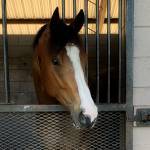Pelvic Fractures in Athletic Horses

Of all the health woes that sideline high-performance horses, musculoskeletal injuries rank highest. Although pelvic fractures occur infrequently compared to other injuries, researchers set out to describe those diagnosed in elite endurance horses.*
In horses, pelvic fractures typically occur as a result of trauma, as might happen when a horse becomes cast, sustains a blow from a kick, spraddles its hind limbs as it slips on ice, or catches a hip bone on the stall-door casing. Pelvic fractures also result as a consequence of repetitive loading during exercise. In susceptible horses, repetitive loading causes microdamage that weakens the bone over time, ultimately leading to fracture. Considered overuse injuries by some, these fractures occur in part because of the long-distance training necessary to build sufficient fitness to compete in endurance successfully.
Researchers surveyed the medical records of endurance horses diagnosed ultrasonographically with bone stress injuries or fatigue fractures of the pelvis. In addition to recording detailed information about the location and configuration of each injury, researchers noted any concomitant unsoundness or injury. Other findings were noted on clinical examination, including asymmetry of bony landmarks of the pelvis, atrophy of muscles that overlay the croup, and pain at the point of the croup.
In the end, 60 endurance horses were included in the study. Of these, 48% had isolated iliac (wing or shaft) fracture, 17% isolated fracture of the pelvic floor, 15% had isolated tuber ischium fracture, and 20% had multiple fractures.

According to the researchers, “bone stress injuries and fatigue fractures of the pelvis can affect endurance horses trained on deep sand and competing at a relatively high speed.” A return to athletic activity for these horses was considered likely.
For many horses with pelvic fractures, convalescence must be spent in confinement. Extended stall rest, up to a full year, may be necessary. Though stall rest is beneficial in the healing process, changes in bone mineral composition during long layups have been documented.
“Bone demineralization can begin to occur in stall-rested horses after just a few weeks of inactivity, so it’s important to consider targeted nutritional supplementation,” explained Catherine Whitehouse, M.S., a nutritionist with Kentucky Equine Research.
One supplement designed specifically for this use is DuraPlex, a proprietary blend of specific proteins, minerals and vitamins scientifically proven to increase bone mineral density and bone area. “Studies at Kentucky Equine Research showed positive changes in bone quality after 30 days of supplementation,” Whitehouse said, “DuraPlex also prevented the natural demineralization that occurs when exercise is restricted, as happens during stall rest due to injury.”
Another product, also developed by Kentucky Equine Research, that would be appropriate for horses on long-term stall rest is Triacton. In addition to its bone-health benefits, Triacton contains buffering agents advantageous for gastric and hindgut health.
Once horses have been assigned stall rest, rations should be modified to reflect the change in workload, Whitehouse said. “For many horses, this may mean an adjustment in the type and amount of forage and concentrate. If left on the same diet, the horse may gain weight or become too exuberant in its stall, both of which could slow healing.”
*Puccetti, M., F. Beccati, and J.-M. Denoix. 2021. Bone stress injuries and fatigue fractures of the pelvis in endurance horses. Equine Veterinary Journal. In press.








